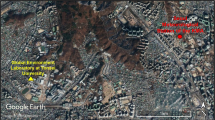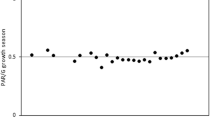Summary
A three-year(1980–82) record of global solar radiation measurements made at Corvallis, Oregon, U.S.A. (44°34′N, 123°14′W; 65.5 m) has been utilized to determine the distribution of radiant energy in broad spectral intervals in the visible (0.385–0.695 μm) region of the spectrum which is often referred to as the photosynthetically active radiation or PAR band. The mean values of the ratios borne by the daily irradiation in the spectral intervals 0.385–0.530 μm and 0.630–0.695 μm, which cover most of the action spectra of plant photochemistry, to the daily total (0.295–2.8 μm) global irradiation are found to be 0.222 (standard deviation: 0.030) and 0.086 (standard deviation: 0.013) respectively; the corresponding ratios in the PAR band and in the spectral interval 0.530–0.630 km are 0.457 (standard deviation: 0.029) and 0.149 (standard deviation: 0.021).
These irradiation ratios exhibit seasonal variations, attributable to changes in local air mass climatology, and dependence on sky conditions, with slightly larger values being observed under “cloudy” skies. The mean value of 0.457 that we have obtained for the irradiation ratio in the PAR band compares favorably with the values reported in the literature for different locations over a wide geographical area. There is reasonable correspondence between the observed irradiation ratios and the computed values in a cloud-free model of a turbid atmosphere.. The sensitivity of the broad-band spectral energy distribution of the global solar radiation to changes in atmospheric turbidity, precipitable water, ozone and surface albedo has been examined in the light of these model computations.
Zusammenfassung
In Corvallis, Oregon, U.S.A. (44°34′N, 123°14′W, 65,5 m) wurden drei Jahre lang (1980–82) Messungen der globalen Sonnenstrahlung angestellt, um die Verteilung der Strahlungsenergie in breiten Spektrumsintervallen im sichtbaren (0,385–0,697 μm) Bereich des Spektrums zu studieren, der oft als photosynthetisch aktive Strahlung (PAR) bezeichnet wird. Die Mittelwerte des Verhaltnisses der taglichen Einstrahlung in den Spektralbereichen 0,385–0,530 μm and 0,630–0,695 μm, welche den Hauptanteil des Strahlungseinflusses auf die Pflanzenphotochemie beinhalten, zu der täglichen Gesamtglobalstrahlung (0,295–2,8 μm) betrugen 0,222 (Standardabweichung 0,030) und 0,086 (Stan dardabweichung 0,013). Die entsprechenden Verhältnisse im PAR-Bereich und im Spektralbereich 0,530–0,630 μm betrugen 0,457 (Standardabweichung 0,029) and 0,149 (Stan dardabweichung 0,021).
Diese Einstrahlungsverhältnisse weisen jahreszeitliche Änderungen auf, die auf lokale Änderungen in der Luftmassenklimatologie zurückgefuhrt werden können und hängen außerdem von der Himmelsbedeckung ab, wobei etwas hohere Werte bei „bewölktem” Himmel beobachtet werden. Der Mittelwert von 0,457, der für das Einstrahlungsverhältnis im PAR-Bereich erhalten wurde, stimmt gut mit Ergebnissen überein, die in der Literatur aus verschiedenen, weit verstreuten geographischen Gebieten erhalten wurden. Es besteht eine gute Beziehung zwischen den beobachteten Einstrahlungsverhältnissen und Werten, die aus einem wolkenfreien, trüben Atmosphärenmodell berechnet würden. Die Sensitivität der breitbandigen Verteilung der Energie im Spektrum der globalen Solarstrahlung gegenüber atmosphärischer Trübung, niederschlagbarem Wasser, Ozon und Bodenalbedo wurde im Lichte dieser Modellrechnungen untersucht.
Similar content being viewed by others
References
Klein, W. H., Goldberg, B., Shropshire, W.: Instrumentation for the Measurement of the Variation, Quantity and Quality of Sun and Sky Radiation. Solar Energy19; 115–122 (1977).
Withrow, R. B.: A Kinetic Analysis of Photoperiodism. Pub. Am. Assoc. Adv. Sci.55, 439–471 (1959).
Miller, D. H.: Energy at the Surface of the Earth. New York: Academic Press 1981.
Bird, R. E., Hulstrom, R. L., Kliman, A. W., Eldering, H. G.: Solar Spectral Measurements in the Terrestrial Environment. Appl. Opt.21, 1430–1436 (1982).
Kvifte, G., Hegg, K., Hansen, V.: Spectral Distribution of Solar Radiation in the Nordic Countries. J. Climate Appl. Met.22, 143–152 (1983).
Rao, C. R. N., Takashima, T., Bradley, W. A., Lee, T. Y.: Near Ultraviolet Radiation at the Earth's Surface: Measurements and Model Comparisons. To appear in Tellus.
Rao, C. R. N., True, K., Bradley, W. A., Dorsch, G., Lee, T. Y.: Solar and Atmospheric Radiation Laboratory, Tech. Rep. No. 1, U.S. DOE Grant DE-FG06-77ET20172, Department of Atmospheric Sciences, Oregon State University, Corvallis, 1980.
World Meteorological Organization: Guide to Meteorological Instrument and Observing Practices. Geneva, WMO Secretariat, 1971.
Rodskjer, N.: Spectral Daily Insolation at Uppsala, Sweden. Arch. Met. Geoph. Biocl., Ser. B33, 89–98 (1983).
DeVault, J. E., Katsaros, K. B.: Remote Determination of Cloud Liquid Water Path from Bandwidth-Limited Shortwave Measurements. J. Atmos. Sci.40, 665–685 (1983).
Goldberg, B., Klein, W. H.: Variation in the Spectral Distribution of Daylight at Various Geographical Locations on the Earth's Surface. Solar Energy19, 3–13 (1977).
Blackburn, W. J., Proctor, J. T. A.: Estimating Photosynthetically Active Radiation from Measured Solar Irradiance. Solar Energy31, 233–234 (1983).
Bird, R. E.: A Simple Solar Spectral Model for Direct-Normal and Diffuse Horizontal Irradiance. Solar Energy32, 461–471 (1984).
Dave, J. V., Halpern, P.: Effect of Changes in Ozone Amount on the Ultraviolet Radiation Received at Sea Level of a Model Atmosphere. Atmos. Environm.10, 547–555 (1976).
Shettle, E. P., Green, A. E. S.: Multiple Scattering Calculation of the Middle Ultraviolet Reaching the Ground. Appl. Opt.13, 1567–1581 (1974).
Shettle, E. P. Fenn, R. W.: Models of the Atmospheric Aerosols and Their Optical Properties. In: Proc. AGARD Conference No. 183: Optical Propagation in the Atmosphere, Lyngby (Denmark), 2.1.–2.16 (1975).
Neckle, H., Labs, D.: Improved Data of Solar Spectral Irradiance from 0.33–1.25. μm. Sol. Phys.74, 231–249 (1981).
Author information
Authors and Affiliations
Rights and permissions
About this article
Cite this article
Nagaraja Rao, C.R. Photosynthetically active components of global solar radiation: Measurements and model computations. Arch. Met. Geoph. Biocl., Ser. B 34, 353–364 (1984). https://doi.org/10.1007/BF02269448
Received:
Issue Date:
DOI: https://doi.org/10.1007/BF02269448




